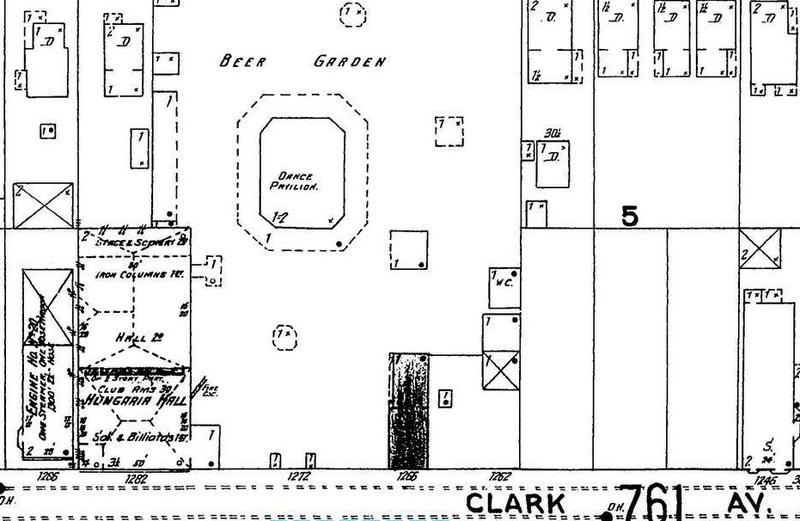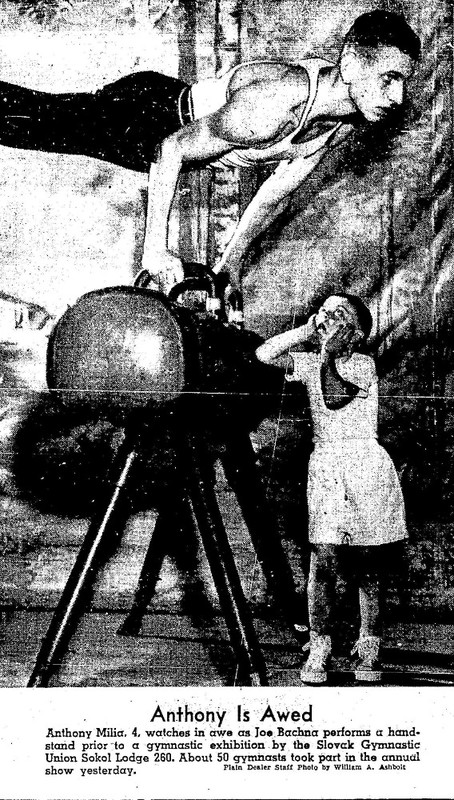Ceska Sin Sokol Hall
The Birthplace of Northeast Ohio College Gymnastics

In the early 1940s, before he was even old enough to cross the street, young Joe Bachna gazed at Ceska Sin Sokol Hall from his father's photography studio at 4203 Clark Avenue. The three and one-half story building located down and across the street at 4314 Clark Avenue, loomed large, both in the immediate neighborhood and in his imagination. Joe dreamed about the day when he too, like his older brothers Alfred, Rudy and Gilbert, could go to the Hall and become a Sokol member, a gymnast.
At the time that Joe Bachna was growing up in this west side neighborhood of Cleveland which was then heavily populated by Czech, Slovak and German-Americans, Ceska Sin Sokol Hall had been home to a number of west side Sokol organizations for nearly 40 years. The Sokols ("Falcons"), a physical education and cultural program founded in Prague in 1862 to promote national solidarity and pride, was part of the culture that Czech immigrants brought with them to America in the second half of the nineteenth century. The first Sokol in America was organized in St. Louis in 1865, and by the 1870s Sokols were being founded among the growing Czech population living in Cleveland.
In the 1890s, Cleveland's west side Czech Sokols--Nova Vlas ("New Country") and Ceska-Zbavny ("Czech Entertainment")-- began purchasing property and building gyms in the Clark-Fulton area. In 1903, they and a number of lodges, clubs and other men's and women's ethnic organizations pooled their resources for the purpose of acquiring a single large hall for all of their activities. Forming a patronat ("board of managers"), they purchased Hungaria Hall in 1907. The hall, which had been built in 1890 by wealthy Hungarian-American magnate Theodore Kundtz, was renamed Ceska Sin Sokol Hall.
During the the years that followed the purchase, thousands of west side neighborhood boys and girls undertook gymnastic training at Ceska Sin Sokol Hall. They also imbibed the Sokol creed of developing strong minds and sound morals to go along with their strong bodies. They practiced, put on exhibitions, engaged in competitions, and, on special occasions, participated in slets (literally "rallies," but actually festivals), where hundreds and sometimes even thousands of Sokol members performed elaborately choreographed gymnastic routines. The Bachna family became involved in these and other Hall activities starting in the 1920s. Joseph Bachna, Sr. and his wife Angela, immigrants from what became Czechoslovakia, were members of a number of clubs and other organizations at the Hall, and their boys at early ages became members of the Slovak Gymnastic Union Sokol.
While all of the Bachna boys developed life-long relationships with Sokol organizations and with Ceska-Sin Sokol Hall, the relationship that one of them developed was to have an enormous impact on the development of college gymnastics in northeast Ohio. Rudy Bachna, whose competitive career was derailed at age 9 when he suffered a crippling injury to his left hand, founded the gymnastic program at Kent State University in 1959. It was the first such college program in northeast Ohio and it quickly became successful, serving as a model for college gymnastic programs across the country. Rudy trained a number of Pan-American and Olympic gymnasts, including Betty Jean Maycock, who won a gold medal at the 1960 Pan-American games and participated in the 1960 Olympics in Rome. In 1980, in recognition of his contributions to college gymnastics, Rudy Bachna was inducted into the Greater Cleveland Sports Hall of Fame. In 1993, two years after his retirement, he and his wife Janet, also a gymnastics coach, were inducted into the Kent State University Hall of Fame.
Today, Sokol gymnasts still train at Ceska Sin Sokol Hall and are still competitive, much like the Bachna boys were more than a half-century earlier. And while their numbers are smaller, these Sokol-trained gymnasts have continued over the years to contribute to northeast Ohio, sometimes in fields other than gymnastics. In 1969, when 17-year-old Peter Sikora, a west side Sokol member of Ceska Sin Sokol Hall, suffered a trampoline accident at St. Ignatius High School that left him a quadriplegic for life, his days as a gymnast were over. But in the Sokol tradition of developing a sound mind as well as a sound body, Peter went on to college and then to law school. He became a lawyer and then a Cuyahoga County Juvenile Court judge in 1989, where he served for 23 years until his death in 2012. Like Rudy Bachna, Judge Sikora too found a way to contribute to his community despite his physical limitations, just as his early gymnastic training at Ceska Sin Sokol Hall would have taught him to do.
Images












